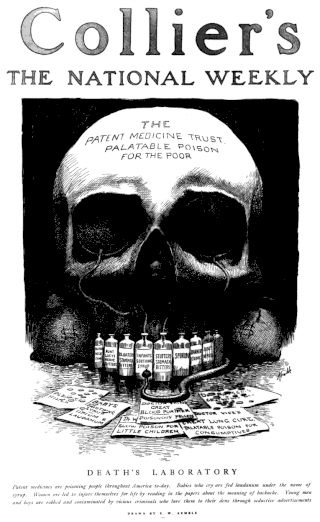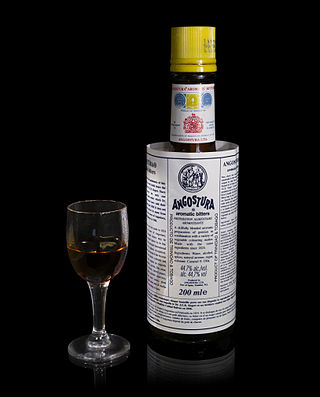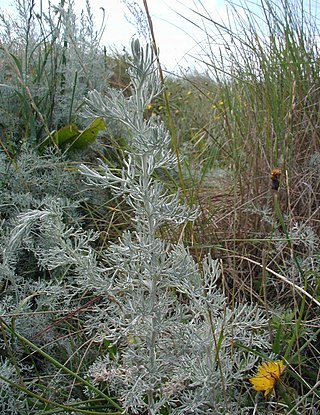
Swedish bitters, also called Swedish tincture, is a bitter and a traditional herbal tonic, the use of which dates back to the 15th century. [1]

Swedish bitters, also called Swedish tincture, is a bitter and a traditional herbal tonic, the use of which dates back to the 15th century. [1]
Swedish bitters is said to have been formulated in a similar way to ancient bitters by Paracelsus and rediscovered by 18th century Swedish medics Dr. Klaus Samst and Dr. Urban Hjärne, though this appears to be mistaking the latter for his son, Kristian Henrik Hjärne, who himself invented a bitter. [2]
In modern times, Swedish bitters have been popularized by Maria Treben, an Austrian herbalist. [2] The tonic is claimed to cure a large number of ailments, and to aid digestion. These claims are presented with little in the way of scientific evidence to support them, though empirical evidence provides for a very large database of positive results. [1] [ better source needed ]
The alcoholic Swedish bitters is purported to have a similar flavor to Angostura bitters , though perhaps drier. Nowadays, it is more common to prepare Swedish bitters from a dry herbs mixture
The following herbs are added to alcohol to make Swedish bitters:
There are variations on this recipe and herbal shops supply alcoholic and non-alcoholic versions of the drink. [3]
Maria Treben's book contains nine pages on this bitter, with a description of many ailments and their cures. [1]

Gin is a distilled alcoholic drink that derives its flavour from juniper berries and other botanical ingredients.

Bitters is traditionally an alcoholic preparation flavored with botanical matter for a bitter or bittersweet flavor. Originally, numerous longstanding brands of bitters were developed as patent medicines, but now are sold as digestifs, sometimes with herbal properties, and as cocktail flavorings.

A patent medicine, sometimes called a proprietary medicine, is an over-the-counter (nonprescription) medicine or medicinal preparation that is typically protected and advertised by a trademark and trade name and claimed to be effective against minor disorders and symptoms. Its contents are typically incompletely disclosed. Antiseptics, analgesics, some sedatives, laxatives, and antacids, cold and cough medicines, and various skin preparations are included in the group. The safety and effectiveness of patent medicines and their sale is controlled and regulated by the Food and Drug Administration in the United States and corresponding authorities in other countries.

Chinese herbology is the theory of traditional Chinese herbal therapy, which accounts for the majority of treatments in traditional Chinese medicine (TCM). A Nature editorial described TCM as "fraught with pseudoscience", and said that the most obvious reason why it has not delivered many cures is that the majority of its treatments have no logical mechanism of action.

Herbal medicine is the study of pharmacognosy and the use of medicinal plants, which are a basis of traditional medicine. With worldwide research into pharmacology, some herbal medicines have been translated into modern remedies, such as the anti-malarial group of drugs called artemisinin isolated from Artemisia annua, a herb that was known in Chinese medicine to treat fever. There is limited scientific evidence for the safety and efficacy of plants used in 21st century herbalism, which generally does not provide standards for purity or dosage. The scope of herbal medicine commonly includes fungal and bee products, as well as minerals, shells and certain animal parts. Herbal medicine is also called phytomedicine or phytotherapy.

Angelica archangelica, commonly known as garden angelica, wild celery, and Norwegian angelica, is a biennial plant from the family Apiaceae, a subspecies of which is cultivated for its sweetly scented edible stems and roots. Like several other species in Apiaceae, its appearance is similar to several poisonous species, and should not be consumed unless it has been identified with absolute certainty. Synonyms include Archangelica officinalis Hoffm. and Angelica officinalis Moench.

Lydia Estes Pinkham was an American inventor and marketer of an herbal-alcoholic "women's tonic" for menstrual and menopausal problems, which medical experts dismissed as a quack remedy, but which is still on sale today in a modified form.

Gammel Dansk is a bitters produced by Arcus-Gruppen in Oslo, Norway, originally developed and produced by Danish Distillers in Denmark. Traditionally it is drunk by Danes at certain festive occasions, often in connection with breakfast meals, brunch or at wedding anniversaries and birthday celebrations. The name "Gammel Dansk" translates directly from Danish as "Old Danish".

Becherovka, formerly Karlsbader Becherbitter, is a herbal bitters, often drunk as a digestif. It is produced in Karlovy Vary, Czech Republic by the Jan Becher company. The brand is owned by Pernod Ricard. It is made from a secret recipe based on more than twenty types of herbs and spices.

Angostura bitters is a concentrated bitters based on gentian, herbs, and spices, produced by House of Angostura in Trinidad and Tobago. It is typically used for flavouring beverages or, less often, food. The bitters were first produced in the town of Angostura, hence the name, but do not contain angostura bark. The bottle is recognisable by its distinctive oversized label. Angostura is Spanish for 'narrowing', the town of Angostura having been at the first narrowing of the Orinoco River.

Artemisia maritima is a European species of wormwood known as sea wormwood and old woman. It is native to France, the United Kingdom, Italy, Belgium, Germany, Denmark, Sweden, Bulgaria and Russia.

Gentiana lutea, the great yellow gentian, is a species of gentian native to the mountains of central and southern Europe.

Kräuterlikör[ˈkʀɔɪtɐlikøːɐ] is a type of liqueur that is flavored with herbs or spices and traditionally drunk neat as a digestif, very close to the concept of an italian amaro.
Shou Wu Chih is a Chinese patent medicine that is claimed to provide health benefits.
Hoxsey Therapy or Hoxsey Method is an alternative medical treatment promoted as a cure for cancer. The treatment consists of a caustic herbal paste for external cancers or an herbal mixture for "internal" cancers, combined with laxatives, douches, vitamin supplements, and dietary changes. Reviews by major medical bodies, including the U.S. Food and Drug Administration (FDA), the National Cancer Institute, the American Cancer Society, M. D. Anderson Cancer Center, and Memorial Sloan-Kettering Cancer Center, have found no evidence that Hoxsey Therapy is an effective treatment for cancer. The sale or marketing of the Hoxsey Method was banned in the United States by the FDA on September 21, 1960 as a "worthless and discredited" remedy and a form of quackery.

Amaro is an Italian herbal liqueur that is commonly consumed as an after-dinner digestif. It usually has a bitter-sweet flavour, sometimes syrupy, and has an alcohol content between 16% and 40%.
Limet is a herbal bitters made in Karlovy Vary in the Czech Republic, flavored with anise seeds, cinnamon, various herbs, and a rich citrus flavor according to a recipe of the Becher family. It is normally served cold, and is often used as an aid to digestion. It can also be served with a tonic water, in which case it is known as a "beton". Its alcohol content is 38 percent. The alcohol is based on the original Becherovka, similarly made from a secret mixture of different herbs.
Maria Trebennée Günzel was an Austrian writer and herbalist who came to fame in the 1980s for her books.

Gentianliqueur is a clear liqueur produced using the roots of the gentian plant.